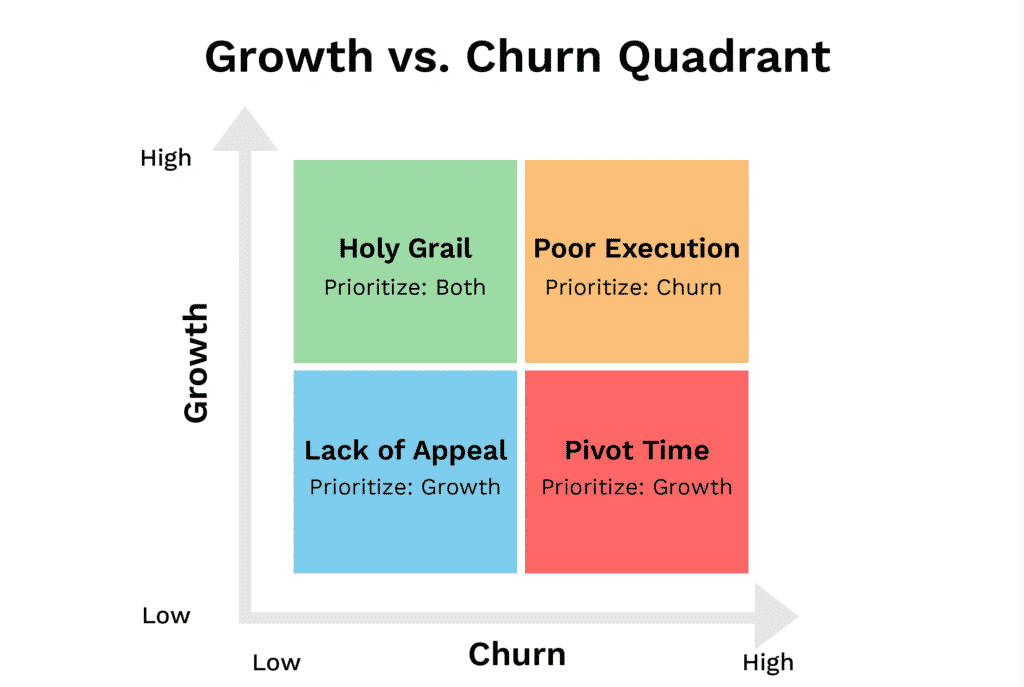Ask any SaaS company about their key metrics, and growth will inevitably come up quickly. Whether they’re exceeding expectations or falling short, how many users being added is an inevitable focus area for the entire organization, and product managers are often tasked with growth-related responsibilities.
But for SaaS businesses to achieve sustainable growth, they can’t focus solely on bringing on new customers. They need to hold onto the ones they already have. Thus, the less exciting but just as important churn metric also gets plenty of attention.
Regardless of which KPIs other departments are focused on, what should be the top priority for product management? Should product priorities be driven by what gets new people to sign up or what leads to a higher percentage of people sticking around? Do you prioritize growth or churn?
Today we’ll look into that dilemma and how it may present for various organizations. Then we’ll spell out a suggested solution.
The growth vs. churn quadrant
Let’s start by looking at when each of these metrics matters more during a product’s lifecycle

1. Low growth, high churn
Whatever you’re doing, it’s not working. You’re hemorrhaging users while failing to add more, so it’s pivot time. Given the goal of righting the ship, growth is a better metric to focus on to see if you’re effectively changing the dynamic by offering and promoting new features and functionality.
2. High growth, high churn
You’re onto something, but the execution is the issue. New users signing on means your messaging and value propositions are cutting it, but users aren’t sticking with the solution. The company can’t afford to keep spending money on user acquisition if those people don’t last for long as paying customers. It’s time to take a deep dive into user behavior analytics, surveys, and interviews to uncover what’s leaving them cold and causing them to abandon ship, so churn takes priority.
3. Low growth, low churn
With a loyal customer base, there’s a strong foundation to build on strategically. Product development efforts can be selectively chosen to experiment with growing the appeal to new pools of users. Marketing activities should also be reevaluated, and the spotlight can shift to growth.
4. High growth, low churn
The holy grail is in your grasp! New users coming in, old users staying put, revenue solely headed in a good direction. Assured that you’ve got a winning combination, do you double-down on growth or try and squeeze that churn rate even lower?
When it’s churn’s turn
Once a product and its growth campaigns have reached maturity and are both performing well, product management can be more strategic and less reactionary in its prioritization. Product market fit has been achieved and glaring problems or shortcomings in the product have been addressed. This is the time to focus on churn.
Let’s look at the numbers. If a company charges $10 per month, each new user means an extra $10 in revenue, and every lost customer means a loss of $10 in revenue. If it was just as easy to add one new customer as it was to retain an existing customer, then it wouldn’t really matter whether a company focused more on growth or reducing churn.
However, there is usually a cost to acquiring each of those new customers. If it costs $100 on average for each new customer, the company doesn’t even break even until month 11. So now the goal is not only to add new customers but to keep them around for at least 11 months to even consider that customer profitable—and that assumes there is zero incremental operating cost to adding and maintaining each customer.
This illustrates why it is so important to reduce churn, and why each saved user is more valuable than each new one. Even when the acquisition cost is only $20, it’s still not until at least Month 3 for them to become profitable, and every customer who doesn’t last represents not only a $10 per month loss in revenue but also any unrecouped money spent on acquiring them.
“Focusing on just one year, if you have a churn of 5% of customers a month, you need to grow a staggering 45% in a year just to remain stable,” says Dave Martin of Tes. “In absolute numbers, starting in January with 2,000 customers suffering a monthly 5% churn and acquiring no new customers, results at the end of December in only 1,080 customers… But with a 1% monthly churn, this product can celebrate annual growth of 715 customers, or 36% growth. ”
Churn means more than lost revenue
Aside from the purely financial impact of a customer unsubscribing, shedding customers has other negative repercussions. If a customer quits—particularly when it’s due to a negative experience—they are potentially a negative growth agent if they share their unsatisfactory experience with other potential buyers.
This can manifest itself in negative online reviews, poor recommendations, or even industry headlines in an enterprise setting. Definitely not helping your Net Promoter Score.
Additionally, as internal executives and outside investors evaluate the company, higher churn rates can raise a red flag about long-term viability. There’s always a ceiling for growth, so stakeholders want to see that even when growth plateaus the business is truly sustainable. If users are consistently canceling their subscriptions, slowed growth can lead to a net negative in monthly revenue over time.
A lost customer is worth more than a new one
The older a customer, the more their departure hurts. New customers are less likely to be a good fit for your product, as the earlier someone adopts the more pressing their need for your solution. Plus that old customer had already paid off their acquisition cost and was a true profit center, while new customers need time to pay that off, plus the amount to acquire them likely was higher as it was more recent.
But you can also learn something from that lost customer, namely why they left. Were they drawn to a competitor? Did the value your solution offered fade over time? Was a missing key feature causing them to bail out? Answering these questions can inform what should be done to retain your current stable of paying customers and attract new ones.
Pay attention to pre-churn indicators
Many people don’t cancel subscriptions the second they stop using them; they might be lazy, want to avoid confrontation, not realize immediately that they’re definitely not using a product anymore, or simply aren’t sure if they’re really going to give it up forever.
Regardless of their reason for putting off cancellation, eventually, those people will pull the trigger after seeing a credit card statement or being asked by their boss why they’re still paying for something they never use. So even if customers aren’t immediately heading for the exits, there’s a chunk of users (or potentially non-users at this point) that represent an imminent cancelation.
There are three reasons to pay attention to this cohort. The first is that if you can recognize the tell-tale signs of a user in wind-down mode they could be eligible for revitalization from customer success or account management. Knowing the indicative metric, in this case, can prioritize those customers for follow-up.
The second is acknowledging that a particular segment of revenue-generating customers can’t be counted on in the long term. These folks are going to churn sooner rather than later, so you shouldn’t bank on their revenue for long.
The final reason is that these churn-inducing behaviors can inform your product strategy.
“You want to actively look for and focus on the scary numbers (the high churn areas) to constantly improve the app,” says Ty Magnin of Appcues. “The trick is to track users’ engagement with different parts of your app. Then, you can figure out which features are less sticky and contribute the most to churn.”
Is churn ever a good thing?
There are cases where losing a customer is a win in the end. They typically come in three flavors:
- Too high maintenance—SaaS businesses succeed with scale, so when a customer needs constant hand-holding and special treatment or customizations, they may not be worth their monthly or annual fee.
- Clinging to the past—When a customer leaves because you no longer support an outdated technology they still want to use, it’s the price of progress, but generally one worth paying.
- Relics of a previous era—Businesses evolve and their new strategies and models may not work for early adopters who signed up for a markedly different service. While you don’t want to leave loyal customers hanging, if it’s a small enough cohort it’s probably best to say goodbye.
Shedding a few old-timers and getting a fresh start with only customers interested in the current offering can avoid distractions and help cull your backlog of irrelevant items.

Don’t forget about negative churn
And of course, there’s “negative churn”—while some customers leave, those that remain to increase their spending.
“In other words, the company still loses 5% of its customer base each month, but the remaining 95% of the customers grow their spend with the startup by 10 percentage points, so the total revenue from the cohort is equal to 105% of the revenue from the previous month,” says Tomasz Tunguz of Redpoint. “Like a savings account, each month, every cohort becomes more valuable.”
This kind of behavior is most common in apps and games featuring in-app purchases or e-commerce sites where customers mimic retail behaviors and shop more often and buy more per trip. You can also achieve negative churn by offering product extensions, upgrades, and add-ons, or even completely new products that compliment your current ones and appeal to the same user base.
Focus on stickiness to defeat churn
At the end of the day, growth isn’t limitless, and every business will see it taper off eventually (see for yourself here). This is why churn trumps growth once a business matures and new customers aren’t constantly busting down your door.
Luckily, churn-reducing strategies lie firmly within the domain of product management and don’t conflict with marketing or require a massive advertising budget. Creating a great product that offers and maintains customer value is what product teams signed up for, so forget those hockey sticks and focus on delighting the customers you already have.
Introduce and promote capabilities you know will resonate with your current user base and increase engagement. Come up with new ways to demonstrate the value of your solution and remind them why they signed up in the first place. And keep an eye on indicators that abandonment is approaching and create a proactive retention strategy.
Remember, something is better than nothing, so if there’s a way to hang onto those existing customers, don’t be afraid to get creative.
“Not every customer that is not satisfied with what they are getting has to leave immediately. Instead, they can switch to a lower plan, or use your product to a lesser degree (for example send fewer emails through your email marketing service),” says Jacob Firuta of LiveChat. “This leads to a smaller revenue you get from that customer or lower lifetime value of the customer (LTV).”
Getting stakeholder buy-in for a churn-driven product strategy isn’t always easy, but luckily the math can usually make the case for you. It may not be as sexy as marketing campaigns that drive growth, but it’s critical to your product’s long-term viability.




